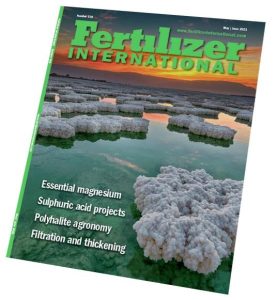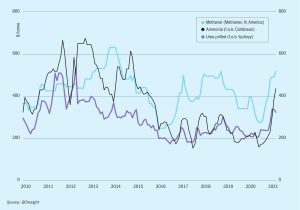
The great green leap forward
As recently as five years ago, decarbonising fertilizer production was little more than an aspiration.

As recently as five years ago, decarbonising fertilizer production was little more than an aspiration.

We compare and contrast the 2020 financial performance of selected major fertilizer producers, following the publication of fourth-quarter results.
CF Industries has signed an agreement with thyssenkrupp to develop a commercial-scale green ammonia project at its Donaldsonville production complex in Louisiana.

Market Insight courtesy of Argus Media
The Chemical & Process Technologies business unit of thyssenkrupp Industrial Solutions is celebrating a milestone in 2021. It is one hundred years since engineer and entrepreneur Friedrich Uhde founded his own plant engineering company in a barn at his parents-in-law’s farm in Dortmund-Bövinghausen on April 6th, 1921. Now, in this centenary year, the origins of the firm are to become visible in its name again: thyssenkrupp is changing the business unit’s name to thyssenkrupp Uhde.

February saw ammonia prices jump due to a series of plant outages, including EBIC in Egypt, and several plants in North America, including two on Trinidad; the 760,000 t/a Nutrien 4 plant and 500,000 t/a Tringen 2 plant, both due to gas shortages, as well as Yara and BASF’s 750,000 t/a unit at Freeport, Texas.

In the March-April issue of Nitrogen+Syngas, Plant Manager+ reported on how to prevent safety risks with a proper leak detection system. In this issue we continue the discussion by further exploring the benefits of vacuum based leak detection systems, which provide several benefits including: less clogging, no build up of pressure, only one ammonia analyser needed for the high pressure equipment, works when there is only one leak detection hole, as well as when there are clogged or no grooves.

The ammonia industry has always dealt with fluctuations in supply and demand as well as volatile feedstock and energy costs. The unexpected global pandemic that started in 2020 has injected a higher degree of uncertainty for ammonia manufacturers’ operating costs and product demand for fertilizer. W. Poe of AVEVA discusses how advanced process control systems can help ammonia producers turn economic uncertainty into a competitive advantage.

Nitrogen+Syngas’s annual listing of new ammonia, urea, nitric acid and ammonium nitrate plants.

Market Insight courtesy of Argus Media